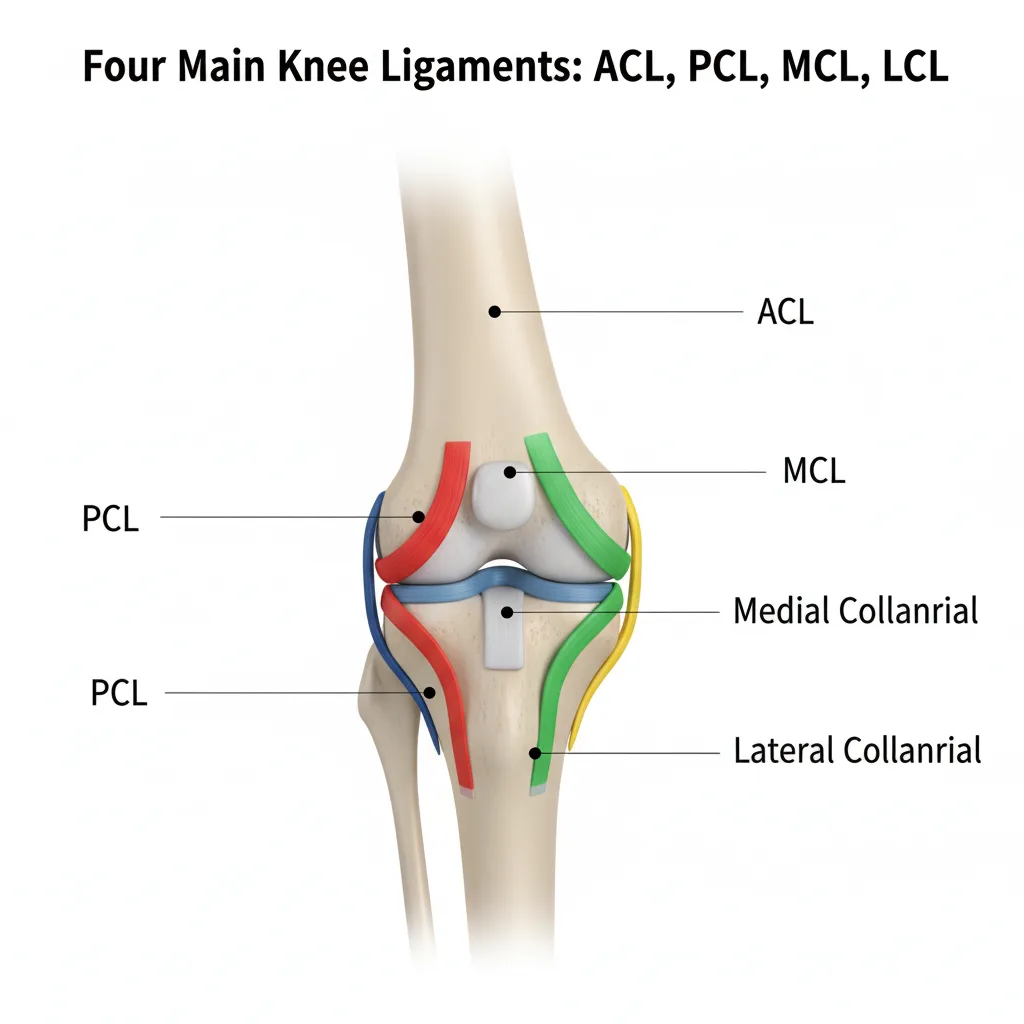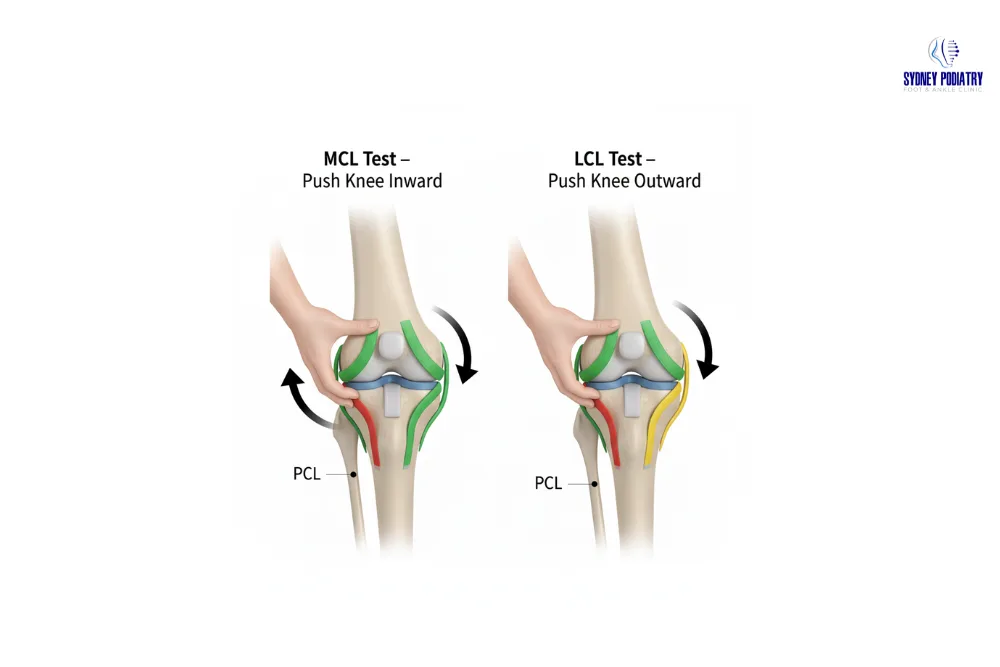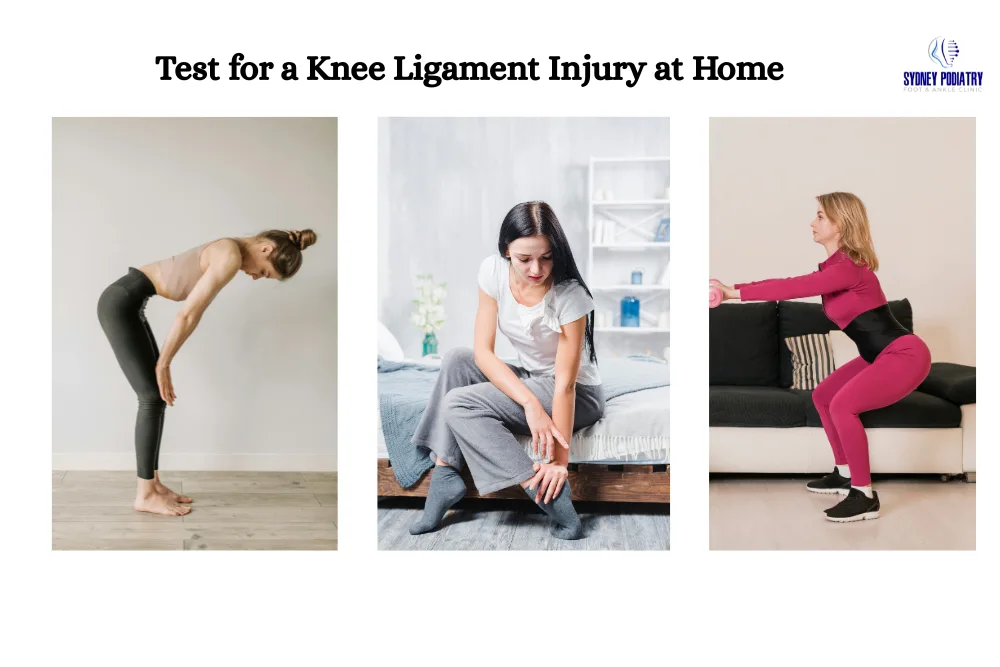The knee is one of the most vital and complex joints in the human body, designed to support movement, stability, and strength. When injured, especially during sport or daily activity, it can be difficult to tell which structure is affected. Understanding how to test for a knee ligament injury at home allows you to identify potential issues early and seek timely professional care.
This article explains how to safely assess the knee for possible ligament injury and what each finding may indicate. It also outlines which signs suggest you should consult a healthcare professional for further evaluation.
Understanding the Knee’s Ligaments
Four primary ligaments stabilise the knee joint:

| Ligament | Location | Function |
|---|---|---|
| Anterior Cruciate Ligament (ACL) | Centre of the knee | Prevents the shinbone from sliding forward |
| Posterior Cruciate Ligament (PCL) | Behind the ACL | Prevents the shinbone from moving backward |
| Medial Collateral Ligament (MCL) | Inner side of the knee | Resists inward bending |
| Lateral Collateral Ligament (LCL) | Outer side of the knee | Resists outward bending |
Each ligament contributes to knee stability. Damage to any of them can cause pain, swelling, and a feeling that the knee may give way.
Preparing for Self-Testing
Before performing any test:
- Sit or lie in a comfortable position on a firm, stable surface.
- Wear loose clothing so the knee is fully visible.
- Relax your leg muscles to allow natural movement.
- Avoid forcing any motion or continuing if pain increases.
Testing should be gentle. The purpose is to assess, not to push the joint beyond its normal limits.
Step 1 :Visual Inspection

Observation provides the first clues to possible injury.
Check for:
- Swelling: One knee appearing larger or puffier than the other may indicate internal inflammation or bleeding.
- Bruising or discolouration: Suggests underlying tissue damage.
- Loss of shape or alignment: The knee may appear distorted or out of position.
Swelling that develops quickly—within a few hours—often suggests an ACL injury. Gradual swelling can indicate PCL or collateral ligament involvement.
Step 2 :Palpation (Gentle Touch Test)
Using your fingertips, feel around the knee to identify tender areas.

| Pain Location | Possible Ligament Involved |
|---|---|
| Inner side | Medial Collateral Ligament (MCL) |
| Outer side | Lateral Collateral Ligament (LCL) |
| Deep within the joint | Anterior Cruciate Ligament (ACL) |
| Back of the knee | Posterior Cruciate Ligament (PCL) |
Tenderness along one side, especially after a twisting or impact injury, often points to a collateral ligament strain. Deep or central pain is more typical of cruciate ligament injury.
Step 3 : Ligament Stability Tests
The following tests replicate what a physiotherapist or podiatrist might perform during a basic assessment. Move gently and note differences between the injured and uninjured knee.
A. Medial Collateral Ligament (MCL) – Valgus Stress Test

- Sit with your leg extended.
- Place one hand on the outer thigh and the other just above the ankle.
- Apply light pressure from the outside of the knee inward.
- Pain or a sense of looseness on the inner side may suggest MCL injury.
B. Lateral Collateral Ligament (LCL) – Varus Stress Test

- Maintain the same position.
- Support the inner thigh and push the lower leg gently outward.
- Discomfort or widening of the outer joint space may indicate LCL damage.
C. Anterior Cruciate Ligament (ACL) – Anterior Drawer Test

- Lie on your back with your knee bent to 90 degrees and your foot flat.
- Secure your foot by sitting on it or having someone hold it.
- Grasp the upper calf just below the knee and gently pull forward.
- If the shinbone moves forward more than on the opposite side or feels unstable, the ACL may be compromised.
D. Posterior Cruciate Ligament (PCL) – Posterior Drawer Test
- In the same position, push your shin backward instead of pulling forward.
- Excessive backward motion or a soft endpoint can indicate a PCL injury.
E. Lachman Test – Sensitive for ACL Integrity
- Bend the knee about 20–30 degrees.
- Hold the thigh steady with one hand and pull the shin forward with the other.
- Abnormal movement or a lack of firm resistance suggests ACL damage.
Always compare both knees, as subtle differences are often the most revealing.
Step 4 : Assessing Movement and Walking

Stand and take a few slow, careful steps across the room:
- Does the knee feel unstable, weak, or prone to giving way?
- Is there pain when turning or changing direction?
- Do you unconsciously avoid putting weight on one leg?
Instability or difficulty pivoting is often linked to ACL injury, while pain on either side may involve the MCL or LCL.
Understanding What Your Results Indicate
| Sensation or Finding | Likely Meaning |
|---|---|
| Sharp pain with swelling | Moderate to severe ligament injury |
| Mild ache without instability | Mild sprain or overuse strain |
| Audible pop at the time of injury | Common with ACL tears |
| Excessive forward or backward motion | Possible ACL or PCL damage |
| Pain with side pressure | MCL or LCL strain |
These observations guide the next step in care. Persistent swelling or instability should be professionally evaluated to prevent long-term complications.
Common Movements That Stress Each Ligament
| Injury Mechanism | Most Affected Ligament |
|---|---|
| Sudden stop or twist | ACL |
| Falling on a bent knee | PCL |
| Impact to outer knee | MCL |
| Impact to inner knee | LCL |
| Sideways motion under load | Collateral ligaments |
Understanding the mechanism of injury can help confirm which structure is involved.
What to Avoid After a Knee Injury
- Avoid heavy exercise, running, or jumping.
- Do not apply direct heat for the first 48 hours.
- Do not force deep knee bending or squatting.
- Avoid wrapping too tightly, which can restrict circulation.
- Refrain from repeated self-testing if the knee remains sore or swollen.
Protecting the joint early can significantly shorten recovery time.
Immediate Home Care: The R.I.C.E. Method

Use the R.I.C.E. protocol to manage pain and swelling:
- Rest: Limit weight-bearing activities.
- Ice: Apply for 15–20 minutes every 2–3 hours.
- Compression: Use a light elastic bandage.
- Elevation: Keep the leg raised above heart level when possible.
For more insight into healing and long-term management, read our in-depth article on torn knee ligament symptoms and recovery at home.
When to Seek Professional Assessment
Arrange a medical evaluation if you experience any of the following:
- Inability to bear weight or extend the knee fully
- Rapid swelling within hours of injury
- A popping sensation followed by pain or instability
- Persistent pain beyond 48 hours despite rest
- Sensation of the knee shifting or giving way
Our team at Sydney Podiatry can perform a comprehensive examination and develop a tailored treatment plan, which may include physiotherapy, bracing, or referral for imaging if required.
Final Thoughts
Performing a structured home assessment helps you understand the condition of your knee and determine whether professional evaluation is needed. While these steps offer useful insight, they are best followed by an expert assessment to confirm the extent of injury and establish an effective treatment plan.
Early recognition and proper management are essential to achieving full recovery and preventing recurrent instability.
FAQs
Can I accurately diagnose a ligament tear at home?
You can identify likely signs of injury, but a confirmed diagnosis requires a professional physical exam or imaging such as MRI.
What is the difference between a ligament sprain and a tear?
A sprain involves stretching of the ligament fibres; a tear means some or all fibres are ruptured. Both cause pain and instability but differ in severity.
How do I tell if my injury is ACL or MCL related?
ACL injuries often cause deep joint pain and instability during turning or pivoting. MCL injuries cause localised pain on the inner side of the knee, usually after a direct impact.
Can knee ligaments heal without surgery?
Mild to moderate sprains typically heal with structured rehabilitation. Complete tears, especially of the ACL, may require surgical intervention for full stability.
How long does recovery from a mild ligament injury take?
Minor sprains can improve within two to four weeks, while moderate injuries may take six to eight weeks. Early assessment and guided rehabilitation are key.
Is it safe to walk with a ligament injury?
If the knee feels stable and pain is minimal, limited walking is generally acceptable. Stop immediately if pain or instability increases.
Should I exercise after a ligament injury?
Only after swelling subsides and under professional supervision. Early rehabilitation focuses on mobility and controlled strengthening.


